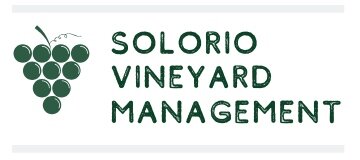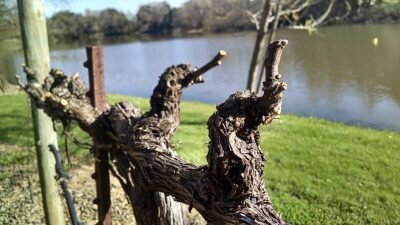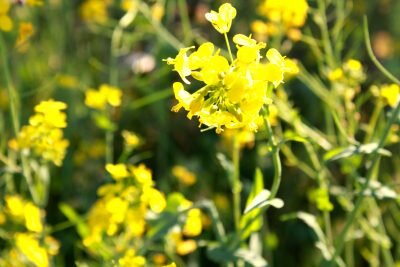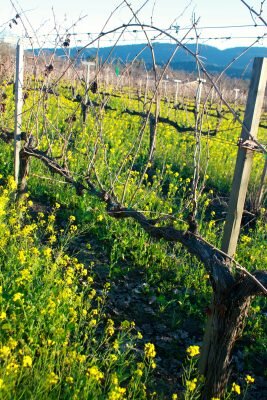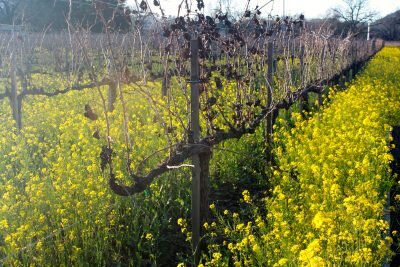Beat the Weather
Note - this post was originally published 02.20.2015
Unlike the East Coast, here in Northern California Spring is coming early. We're finishing up pruning vineyards and tying them to their trellises before the vines start showing their new growth.
This picture is of Pinot Noir grapes in the Russian River Valley:
Out with the Old
Note - this post was originally published 02.15.2015
After finishing taping & tying the vines - time to remove the brush and leave everything nice and clean.
Taping & Tying
Note - this post was originally published 02.11.2015
After pruning the vines, when the weather starts to warm and the new growth is flexible, we tie the vines to the trellis system to train them and lend structural support. After the rains this past weekend, we're back in the vineyards taking care of the vines.
A Feeling of Expectation
Note - this post was originally published 02.07.2015
Hope: a feeling of expectation and a desire for a certain thing to happen. This week in the vineyard we spotted a leaf. In the middle of winter, a pop of color, a sign of life, and the first look at the 2015 vintage. Cheers!
Winter Yellows
Note - this post was originally published 02.01.2015
One of the seasonal wonders of Napa Valley that we look forward to each year is the yellow mustard. After the first serious rains of winter - usually in January - these bright yellow flowers, knee-high in height, bloom throughout the vineyards. Miles of yellow, a sea of flowers divided into waves among the rows of grape vines.
In the Vineyard - Pruning
This post was originally published 01.31.2015
Winter, when the plants are dormant, is the time to prune the vines and focus growth for the coming vintage. We generally prune vineyards in January and February. This week we're in the Russian River Valley working with Pinot Noir.
All About the Barrel, All About the Barrel
Note - this post was originally published 01.29.2015
Life slows down a little bit in Napa Valley in the winter. The tourists are mostly at home, the vines are dormant, and we get prepare for the coming vintage. This week Francisco helped worked at a winery clearing out the cellar and moving old barrels out.
Pressing Off the Wine
Note - this post was originally published 11.14.2014
It's been a busy harvest season. This morning we're pressing off some wine. The wine has finished fermentation and we're pressing the grapes and draining off the wine. Cheers!
September = California Wine Month
Note - this post was originally published 09.11.2014
It's official. The governer decreed it: September 2014 is California Wine Month. Not every September, just this one as an effort to boost morale and let tourists know that we're still here and we still have lovely grapes to harvest and wines to pour and sell.
Governor Brown includes a history of the wine industry in this State (and we thought he'd talk about economic impact): http://gov.ca.gov/news.php?id=18686
Below are a couple photos we took this week of Cabernet Sauvignon grapes ripening in the afternoon sun in St. Helena. Cheers!
Picking Pinot Noir
Note - this post was first published 09.09.2014
It’s a great feeling when you get to see a project through. That’s how we felt last week when we had the opportunity to pick a Pinot Noir vineyard in the Russian River Valley that we had started working in January of this year.
When you work with grapes, the job is to nurture each vine individually and manage the vineyard as a whole. When to pick the finished product – ripe grapes – is actually up to the winemaker. Whoever is purchasing the grapes is using them as the raw materials for a beautiful wine. The growing season, elements, geographical features of the vineyard, and vineyard management techniques will all have effects on flavor. But the style of wine (bursting fruit flavors, bigger wines with higher alcohol contents vs. more traditional lighter alcohol wines with more restrained characteristics that might develop more over time, etc) starts with when to pick – at what levels the acidity and sugar exist in the grape.
Pinot Noir is a thinner skinned grape that ripens before thicker skinned grapes like Cabernet Sauvignon and Petite Sirah.
Here’s to the 2014 vintage, cheers!
Foraging - Pomegranates
Note - this post was originally published 09.08.2014
Foraging for food is eating local, culinary nouveau - it's so old it's back "in" again. I’m always terrified of the prospect because I live under the assumption that I’ll be one of those who picks a pretty poisonous plant and literally dies of ignorance. Enter my better half, who grew up on a ranch, working and enjoying the outdoors.
Long story short, we’ve savored a number of sweet natural treats, exotic to me, mundane for him. Little treasures hidden in plain sight. This week: Granadas! Pomegranates!
Earthquake
Note - this post was originally published 09.05.2014
As you probably know two weeks ago we had and experienced a 6.0 earthquake in Napa Valley. The epicenter was in the town of American Canyon just south of the town of Napa at the southern end of the Valley. We’re up at the northern end of the Valley and luckily did not experience as much damage, but definitely felt the quake.
So, we weren’t hurt and our home is intact, just a bit shaken up (forgive the pun). In the southern end of the valley, especially near the old part of downtown Napa buildings of all kind were damaged. In a valley that now depends on tourism, especially this time of year, the worry now is that people are canceling their plans to visit.
We’re ok. Wineries are open for tasting and grapes are being picked daily now that harvest has started. It’s still an exciting time to be in the valley. Happy September!
Almost Harvest Time
Note - this post was originally published 8.14.2014
The grapes are ripening, trucks are moving bins and tanks up and down the Valley... harvest should start here soon - in the next week or two.
Some of the bounty to be picked, then crushed and fermented:
Nets
Note - this post was originally published 8.07.2014
The grapes have undergone veraison – the onset of ripening when the color of the berries (grapes) change color. Until now both the red and white varieties have been green. Literally.
In some of the vineyards we take care of, we’ve had to net the vines against local birds who have also noticed the ripening fruit.
Hot Air Balloons
Note - this post was originally published 08.05.2014
One of our favorite things about Napa Valley in the summer, is the chance to watch hot air balloons pass over head early in the morning. Beautiful colors gliding over the vineyards. One of these days we'll be the people in the balloon at dawn's early light, but for now we're the ones in the vineyard, looking up and enjoying the view.
Limoncello Update
Note - this post was originally published 07.08.2014
After waiting an extra two months, we moved on to phase two of our limoncello project. We were waiting for all the essence, color, and natural oils to infuse into the alcohol and out of the lemon peel. This should have left the peels white and crisp. With our last batch, this process took about two months. With this batch, we used more lemons and if it’s possible a more yellow type of lemon, and after four months the color and aroma were amazing, but the lemon peels still flexible. We made the executive decision that it was time to continue.
Next, we made a simple syrup and allowed it to cool to room temperature. We then removed the peels from the limoncello with a large slotted spoon. Then filtered, and filtered, and filtered the limoncello. We returned our liquid gold to the sterile glass container we use for aging and slowly mixed in our simple syrup. Now we wait. Again.
Bubbles!
Note - this post was originally published 07.07.2014
There are so many reasons to celebrate during this festive and outdoors-friendly season. And with the warmer weather chilled drinks are more than appropriate, so we say bring out the bubbles! We love to share a bottle of champagne and whether you serve it as an aperitif, with your meal, with dessert, to bring in a touch of romance, or to invoke a celebratory mood, by all means pop the cork, sip, and smile.
Here is some general information to keep in mind or guide you as you look for bubbles to suit your day:
Prosecco - Italian sparkling white wine. Secondary fermentation (which creates the bubbles) typically occurs in large stainless steel tanks, unlike champagne where secondary fermentaion occurs in the bottle and the wine is aged before release. This results in a wine meant to drink young and taste fresh, light, and simple. Think $10-$20 bottle from the grocery store.
Champagne – Sparkling wine produced in the Champagne region of France. Secondary fermentation occurs in the bottle and the grapes used for the wine are Pinot Noir, Pinot Meunier, and Chardonnay. The wine is aged a minimum of 18 months. In exceptional growing years the wine is made from a single vintage, otherwise the final wine is a blend of both grapes and vintages. Think $60 - $250/bottle from your local wine shop.
Cava - Spanish sparkling wine, white or rose, produced in the traditional Méthode Champenoise / Método Tradicional (secondary fermentation in the bottle), made mainly from indigenous Spanish grapes. Great value $6 - $20/bottle from large wine shop or local grocery store.
California Sparkling wine - modeled after French champagne, including using French grape varietals grown in California. Prices can vary from $15 (Korbel) – $150 (J. Schram), other California sparkling houses to note – Iron Horse (served at the White House), Mumm, Rack & Riddle, Roederer (their estate brut is an awesome value), and Schramsberg.
Food pairings: bubbles and crisp acidity balance creamy or fried dishes such as fish and chips, buttered popcorn, lobster, a creamy chowder, or even cheese cake.
Inspiration and good sparkling read: Tasting Dom Perignon from Various Decades
Summertime
Note - this post was originally published 07.05.2014
It's not all grapes out here in Napa Valley. We've got beautiful cactus/nopales too! Enjoying the beauty of the hot and dry California Summer.
Russian River Valley Pinot Noir
Note - this post was originally published 06.29.2014
Grapes! Our pruning efforts paid off. Here are some Russian River Pinot Noir grapes growing, growing, growing.
Saving the Wine: Storing the Wine
Note - this post was originally published 6.11.2014
We've had another little heat wave (highs over 100 deg F) this week. Which beyond the desires for mounds of frozen yogurt and to seek the nearest swimming hole, has brought up the topic of how to store wine.
Wine is fragile. It's important to keep it out of direct light and heat - think of the ideal conditions of an under-ground cellar: consistently cool, dark, and damp. Then make sure you keep the cork wet by storing the bottles on their side or upside down and you've got potential to age your wine and enjoy it in the months or years to come.
It's also important to remember that it can even cook as you're touring around or on your way home. Here in wine country there are so many wonderful opportunities to pick up a bottle you wouldn't be able to get else where. At temperatures over 70 deg F the wine will start to cook and worse case scenario, the cork will push out of the bottle, the wine leak out, and to say the least your special bottle will be spoiled. So, save the wine. Think of it like chocolate. Don't put it in the trunk of your car, keep it in the cabin with you and if you must leave it in the car, then park in the shade and crack the windows.
The best article we've read about this lately is last week's article in the Financial Times by Jancis Robinson, How to keep wine.
